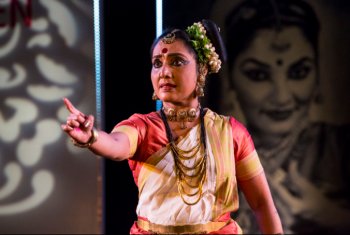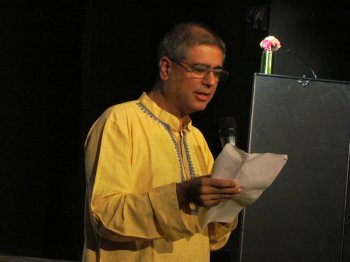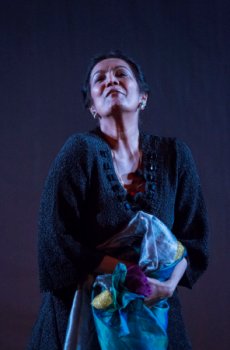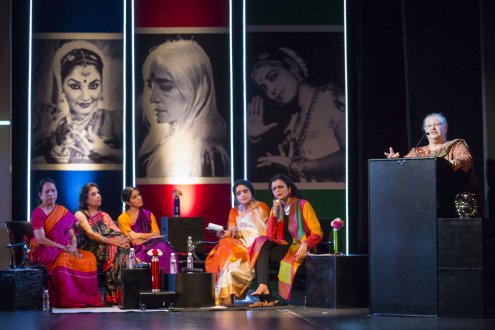
|   |

|   |
Natya Darshan Seminar EPIC WOMEN - Conference / Performance conclave DAY 2 – Defining and defying gender roles - Kiran Rajagopalan e-mail: kiran.rajagopalan@gmail.com Photos: Vipul Sangoi December 22, 2012 The second day of “Epic Women” began with Dr. Neena Prasad’s ‘Surpanakha – A Passion Disgraced, Womanliness Mortified!’ Her moving, but unsettling interpretation of the title character was based on a modern Malayalam poem which delves into the controversial issues of casteism and feminine sexuality in Ramayana. As an “ordinary woman of lower class,” Surpanakha boldly questions Rama’s humanity after her frank expression of love leaves her brutally mutilated. Flashbacks of Surpanakha’s first glimpse of Rama and the famous episode in which she is tussled between Rama and Lakshmana were sensitively depicted through Dr. Prasad’s nuanced abhinaya. Yet, even those moments had an underlying poignancy which cleverly reinforced the tragedy of Surpanakha’s suffering despite being a despised character.  Dr. Neena Prasad  Mahesh Dattani (Photo: Lalitha Venkat) In fact, Mahesh Dattani’s session, informally titled ‘Epic Women we love to hate,’ examined this dilemma further. He argued that women who induce crises in Indian literature are “victims of storytelling” based on conventions set by writers – the majority of whom were male and belonged to the upper castes. Not surprisingly, society has been shaped to view “desirable women” as physically beautiful, noble, chaste, and submissive. Therefore, “undesirable” characters were often portrayed as lowly, deformed, and ugly women who planted the seeds of devastation in inherently “desirable” ones – as in the case of Mantara and Kaikeyi, respectively. Yet, how does society respond to women whose complexity prevents them from being categorized so rigidly?  Chitra Sundaram Chitra Sundaram sought to answer this question in her performative piece ‘Sthree-Dom: An Immaculate Conception,’ on the parallel lives of Arundhati and Penelope. Chitra used spoken dialogue, hand gestures, melodious music, visually striking props to re-tell these characters’ stories though a uniquely modern voice. Both women are conventionally celebrated as shining examples of chastity, but they clearly suffered silently in the subservient roles they played. Arundhati was regarded as an equal to the saptharishis, but she “dimmed” her brilliance in order to stand behind her husband, Sage Vasishta. Likewise, Penelope’s exceptional resourcefulness enabled her to remain faithful to Odysseus for decades even as she tirelessly fought off the advances of licentious princes. Still, Arundhati and Penelope remain in the shadows as “wives and afterthoughts,” and Chitra chose to touch upon their resentment at being overlooked in favor of their eminent husbands.  Nandini Ramani, Sukanya Rahman, Padmini Chettur, Avanthi Meduri, Anita Ratnam, Katherine Kunhiraman The day ended with a lively panel discussion on ‘Epic Women in Indian Dance’ with Katherine Kunhiraman, Nandini Ramini, Padmini Chettur, and Sukanya Rahman discussing the extraordinary women they studied under. Katherine began the session with a brief overview of the Arts and Crafts Movement (c. 1860-1910) and how it deeply influenced Rukmini Devi Arundale’s vision for Kalakshetra. Nandini Ramani shared her thoughts on T. Balasaraswati’s exceptional knowledge of music and her meticulous approach to teaching. She even sang and demonstrated part of a padam as taught to her by Balasaraswati! Sukanya also treated rasikas to a candid account of Indrani Rahman’s life and to a lovely vintage video clip of her dancing the Manduka Shabdam with an introduction by Pandit Ravi Shankar! Padmini Chettur’s eloquent discussion about Chandralekha’s unique approach to movement was the highlight of the panel. Chandralekha understood that movement originates from stillness, radiates through the spine, and finally displaces the body through time and space. More importantly, Chandralekha believed that everyone has the potential to become dancers if their inner consciousness is correctly channeled. Consequently, she did not look for technical virtuosity when recruiting dancers, per se. Dr. Ratnam had to end the lively panel discussion rather prematurely as the conference ran over time. Nevertheless, the second day was enriching as all the sessions seemed to be linked with the idea of women who define and defy classically feminine gender roles. Kiran Rajagopalan is a Bharatanatyam dancer and writer. |